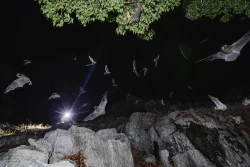
Bat scientist Doug Mills observes a fly-out of threatened eastern bentwing bats. These bats congregate in 'maternal roosts' for several months every year, where females will give birth to and raise their young. This provides the perfect opportunity for Doug to assess the numbers of this threatened species. Doug videos the fly-out with a thermal camera and then uses an AI algorithm that analyses the footage and provides an accurate population estimate. This information will hopefully inform how climatic changes influence the numbers of this otherwise understudied species. At the hight of the fly-out, around one thousand bats are exiting the roost per minute.
**ETHICS** this image is a composite of several images taken from the same position and time, to properly illustrate the sheer number of bats exiting the roost while Doug monitors them. I was positioned behind and facing away from the roost entrance, and following Doug's advice on what distance or lighting levels would be likely to disturb or change the behaviour of the bats.
This project is part of the Saving our Species program.
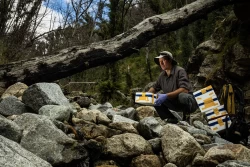
Threatened Species Officer David Hunter assesses a pristine pool in a remote stretch of stream in Australia's alpine region. Inside the boxes Dave has walked into this location are precious cargo - around 80 critically endangered spotted tree frogs.
These frogs were declared extinct in NSW in the mid-2000's, but a captive breeding program saw them released back into the state in 2015, at a location that was considered safe from the amphibian chytrid virus. This population was going well until the 2019-20 bushfires devastated the region, bringing it back to just 12 frogs.
In February 2022 an additional 80 frogs were released into the stream to try and rebuild this stronghold for the species within NSW.
This project is part of the Saving our Species program.
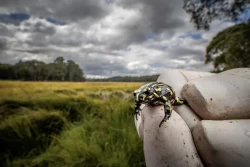
This is a male northern corroboree frog (one of only around 900 left in the wild) in the hand of Saving our Species frog guru David Hunter. This spectacular frog is in dire straights due to disease caused by the amphibian chytrid fungus and habitat destruction, but thanks to some human intervention we're trying to get them back on track. A big component of this project is a robust captive breeding program that is seeing both adult frogs and eggs reintroduced into the wild to bolster existing populations. The project involves many partners and demonstrates what can be achieved when we all pull in the same direction to achieve conservation goals.
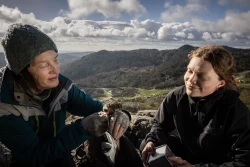
Almost four years after the fires, the alpine landscapes of Kosciuszko are recovering and annual surveys have consistently revealed healthy populations of the mountain pygmy possum at all sites.
This project is part of the NSW Saving our Species program.

The unprecedented 2019-20 bushfires devastated Australia's alpine regions within Kosciuszko National Park, including the boulder field habitat of the Critically Endangered mountain pygmy possum.
National Parks and Saving our Species staff entered active firegrounds days after they had passed over the boulder fields to distribute supplementary feeding and watering stations. The fires removed all of the food resources that pygmy possums rely on - primarily bogong moths and the mountain plum pine plant.
This project is part of the NSW Saving our Species program.
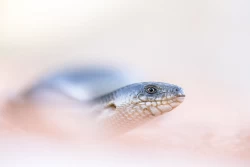
An endangered mallee slender blue-tongue skink. One of many amazing threatened reptiles from Australia's arid zone.
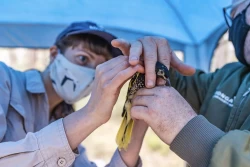
A critically endangered zoo-bred regent honeyeater is fitted with a radio tracking collar prior to its release. The entire population of this bird is thought to be just 300 individuals.
This project is part of the NSW Saving our Species program.
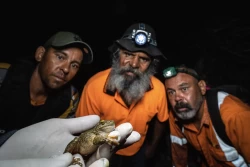
Following the release of 80 critically endangered spotted tree frogs in 2022, yearly follow-up surveys have revealed the population is booming with over 200 frogs, tadpoles and metamorphs observed recently in 2024.
Indigenous men from Wolgalu and Wiradjuri country have been heavily involved in these surveys and in other aspects of the project, pictured here observing a frog that is one of the 12 survivors of the 2019-20 bushfires.
This project is part of the Saving out Species program.
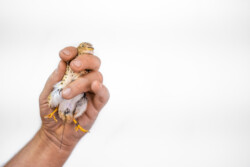
A captive-bred plains wanderer is fitted with a tracking device and inspected for any health issues before it is released into the wild. Taken for DPE/Saving our Species.
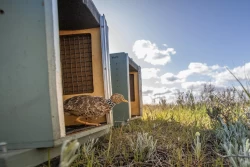
A zoo-bred critically endangered Plains Wanderer takes its first steps into the wild. This bird is equipped with a satellite tracking 'backpack' so scientists are able to follow its movements for the months following its release.
These releases occur on private land, where farmers are modifying their grazing practices to create habitat that perfectly suits the Plains Wanderer.
This project is part of the Saving our Species program.
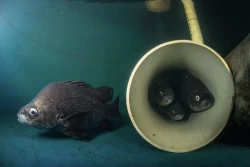
The Macquarie perch is the closest living relative to the Kangaroo River perch, and is on the brink of extinction due to the continued degradation of Australia's river systems. The Department of Primary Industries fisheries research team have begun establishing ex-situ populations of the species to safeguard them for future generations, and to ensure this species doesn't suffer the same fate as the Kangaroo River perch.
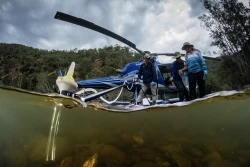
Luke, Erin and Felicity are members of different government organisations that have teamed up to find a species of native fish, the Kangaroo River perch. This perch was last seen in 1998 and is known to be a distinct species based on the genetics of one preserved specimen.
The team are using environmental DNA technology to survey historic and remote locations the fish was found, in the hope of finding answers as to why this species has experienced such a rapid decline, and if it may have gone extinct.
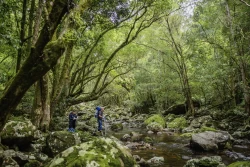
The Kangaroo River perch was last seen in 1998 in Kangaroo River, pictured here.
Using environmental DNA technology to survey historic and remote locations the fish was found, a team of scientists hope to find answers as to why this species has experienced such a rapid decline, and if it may have gone extinct.
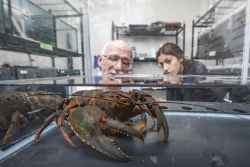
University of Wollongong professor Andy Davis, along with honors student Melissa Antoun, observe a large Euastacus spinifer in one of their labs. Currently they are studying how the presence of the invasive common yabby (Cherax destructor) impacts Euastacus behaviour.
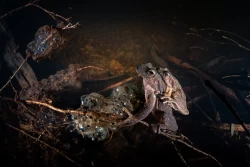
A pair of threatened southern heath frogs (Litoria wastoni) doing their bit to ensure the continuation of their species.
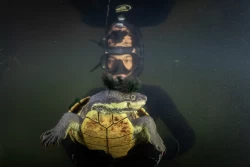
The Manning River turtle (Flaviemys purvisi) is entirely endemic to the Manning River on the east coast of Australia. Scientists regularly snorkel this river system to check up on the population of this endangered species, assessing the health of every individual they come across.
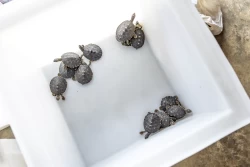
In 2015, it took just six weeks for a mysterious virus to wipe out 90 per cent of the Bellinger River snapping turtles' population.
At the time, 16 healthy turtles were placed into a zoo-based captive breeding program at Taronga Zoo that later expanded to Symbio Wildlife Park.
Almost ten years later, in late 2023, 97 zoo-bred Bellinger River snapping turtles were bagged up, put in big tubs and transported all the way from Sydney to Bellingen.
This image shows the turtles on their arrival the night before the release, where ecologists and zoo keepers assessed each individual's health and recorded important characteristics so each turtle could be identified.
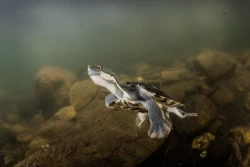
As their common name hints at, the Bellinger River is the only place in the world that the Bellinger River snapping turtle (Myuchelys georgesi) is found.
Since 2018, 179 zoo-bred turtles have been released back into the River system following a mysterious virus that wiped out 90% of their population. With the latest release, which occurred late last year, it's now thought the number of zoo-bred turtles in the river surpasses the number of wild turtles.
While this may seem like a depressing fact, these zoo-bred turtles represent hope for future of the species. The actions of the scientists back in 2016 ensured healthy individuals were entered into a captive breeding program, as without this intervention the situation would no doubt be a lot worse.












